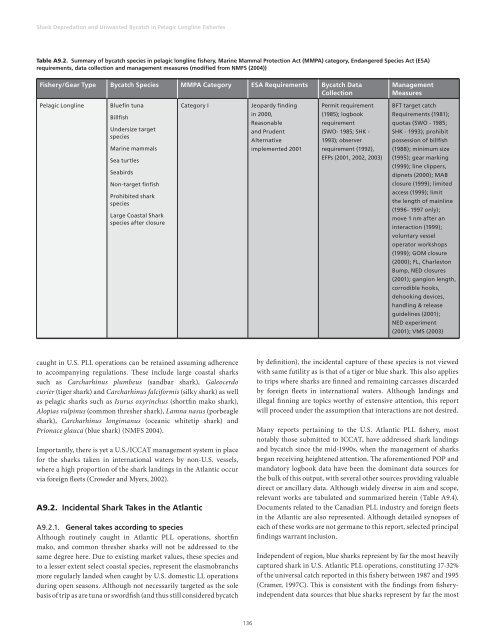Shark Depredation and Unwanted Bycatch in Pelagic Longline
Shark Depredation and Unwanted Bycatch in Pelagic Longline
Shark Depredation and Unwanted Bycatch in Pelagic Longline
Create successful ePaper yourself
Turn your PDF publications into a flip-book with our unique Google optimized e-Paper software.
<strong>Shark</strong> <strong>Depredation</strong> <strong>and</strong> <strong>Unwanted</strong> <strong>Bycatch</strong> <strong>in</strong> <strong>Pelagic</strong> Longl<strong>in</strong>e Fisheries<br />
Table A9.2. Summary of bycatch species <strong>in</strong> pelagic longl<strong>in</strong>e fishery, Mar<strong>in</strong>e Mammal Protection Act (MMPA) category, Endangered Species Act (ESA)<br />
requirements, data collection <strong>and</strong> management measures (modified from NMFS (2004))<br />
Fishery/Gear Type <strong>Bycatch</strong> Species MMPA Category ESA Requirements <strong>Bycatch</strong> Data<br />
Collection<br />
Management<br />
Measures<br />
<strong>Pelagic</strong> Longl<strong>in</strong>e<br />
Bluef<strong>in</strong> tuna<br />
Billfish<br />
Undersize target<br />
species<br />
Mar<strong>in</strong>e mammals<br />
Sea turtles<br />
Seabirds<br />
Non-target f<strong>in</strong>fish<br />
Prohibited shark<br />
species<br />
Large Coastal <strong>Shark</strong><br />
species after closure<br />
Category I<br />
Jeopardy f<strong>in</strong>d<strong>in</strong>g<br />
<strong>in</strong> 2000,<br />
Reasonable<br />
<strong>and</strong> Prudent<br />
Alternative<br />
implemented 2001<br />
Permit requirement<br />
(1985); logbook<br />
requirement<br />
(SWO- 1985; SHK -<br />
1993); observer<br />
requirement (1992),<br />
EFPs (2001, 2002, 2003)<br />
BFT target catch<br />
Requirements (1981);<br />
quotas (SWO - 1985;<br />
SHK - 1993); prohibit<br />
possession of billfish<br />
(1988); m<strong>in</strong>imum size<br />
(1995); gear mark<strong>in</strong>g<br />
(1999); l<strong>in</strong>e clippers,<br />
dipnets (2000); MAB<br />
closure (1999); limited<br />
access (1999); limit<br />
the length of ma<strong>in</strong>l<strong>in</strong>e<br />
(1996- 1997 only);<br />
move 1 nm after an<br />
<strong>in</strong>teraction (1999);<br />
voluntary vessel<br />
operator workshops<br />
(1999); GOM closure<br />
(2000); FL, Charleston<br />
Bump, NED closures<br />
(2001); gangion length,<br />
corrodible hooks,<br />
dehook<strong>in</strong>g devices,<br />
h<strong>and</strong>l<strong>in</strong>g & release<br />
guidel<strong>in</strong>es (2001);<br />
NED experiment<br />
(2001); VMS (2003)<br />
caught <strong>in</strong> U.S. PLL operations can be reta<strong>in</strong>ed assum<strong>in</strong>g adherence<br />
to accompany<strong>in</strong>g regulations. These <strong>in</strong>clude large coastal sharks<br />
such as Carcharh<strong>in</strong>us plumbeus (s<strong>and</strong>bar shark), Galeocerdo<br />
cuvier (tiger shark) <strong>and</strong> Carcharh<strong>in</strong>us falciformis (silky shark) as well<br />
as pelagic sharks such as Isurus oxyr<strong>in</strong>chus (shortf<strong>in</strong> mako shark),<br />
Alopias vulp<strong>in</strong>us (common thresher shark), Lamna nasus (porbeagle<br />
shark), Carcharh<strong>in</strong>us longimanus (oceanic whitetip shark) <strong>and</strong><br />
Prionace glauca (blue shark) (NMFS 2004).<br />
Importantly, there is yet a U.S./ICCAT management system <strong>in</strong> place<br />
for the sharks taken <strong>in</strong> <strong>in</strong>ternational waters by non-U.S. vessels,<br />
where a high proportion of the shark l<strong>and</strong><strong>in</strong>gs <strong>in</strong> the Atlantic occur<br />
via foreign fleets (Crowder <strong>and</strong> Myers, 2002).<br />
A9.2. Incidental <strong>Shark</strong> Takes <strong>in</strong> the Atlantic<br />
A9.2.1. General takes accord<strong>in</strong>g to species<br />
Although rout<strong>in</strong>ely caught <strong>in</strong> Atlantic PLL operations, shortf<strong>in</strong><br />
mako, <strong>and</strong> common thresher sharks will not be addressed to the<br />
same degree here. Due to exist<strong>in</strong>g market values, these species <strong>and</strong><br />
to a lesser extent select coastal species, represent the elasmobranchs<br />
more regularly l<strong>and</strong>ed when caught by U.S. domestic LL operations<br />
dur<strong>in</strong>g open seasons. Although not necessarily targeted as the sole<br />
basis of trip as are tuna or swordfish (<strong>and</strong> thus still considered bycatch<br />
by def<strong>in</strong>ition), the <strong>in</strong>cidental capture of these species is not viewed<br />
with same futility as is that of a tiger or blue shark. This also applies<br />
to trips where sharks are f<strong>in</strong>ned <strong>and</strong> rema<strong>in</strong><strong>in</strong>g carcasses discarded<br />
by foreign fleets <strong>in</strong> <strong>in</strong>ternational waters. Although l<strong>and</strong><strong>in</strong>gs <strong>and</strong><br />
illegal f<strong>in</strong>n<strong>in</strong>g are topics worthy of extensive attention, this report<br />
will proceed under the assumption that <strong>in</strong>teractions are not desired.<br />
Many reports perta<strong>in</strong><strong>in</strong>g to the U.S. Atlantic PLL fishery, most<br />
notably those submitted to ICCAT, have addressed shark l<strong>and</strong><strong>in</strong>gs<br />
<strong>and</strong> bycatch s<strong>in</strong>ce the mid-1990s, when the management of sharks<br />
began receiv<strong>in</strong>g heightened attention. The aforementioned POP <strong>and</strong><br />
m<strong>and</strong>atory logbook data have been the dom<strong>in</strong>ant data sources for<br />
the bulk of this output, with several other sources provid<strong>in</strong>g valuable<br />
direct or ancillary data. Although widely diverse <strong>in</strong> aim <strong>and</strong> scope,<br />
relevant works are tabulated <strong>and</strong> summarized here<strong>in</strong> (Table A9.4).<br />
Documents related to the Canadian PLL <strong>in</strong>dustry <strong>and</strong> foreign fleets<br />
<strong>in</strong> the Atlantic are also represented. Although detailed synopses of<br />
each of these works are not germane to this report, selected pr<strong>in</strong>cipal<br />
f<strong>in</strong>d<strong>in</strong>gs warrant <strong>in</strong>clusion.<br />
Independent of region, blue sharks represent by far the most heavily<br />
captured shark <strong>in</strong> U.S. Atlantic PLL operations, constitut<strong>in</strong>g 17-32%<br />
of the universal catch reported <strong>in</strong> this fishery between 1987 <strong>and</strong> 1995<br />
(Cramer, 1997C). This is consistent with the f<strong>in</strong>d<strong>in</strong>gs from fishery<strong>in</strong>dependent<br />
data sources that blue sharks represent by far the most<br />
136












